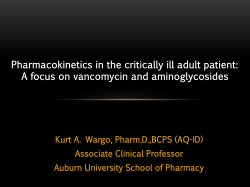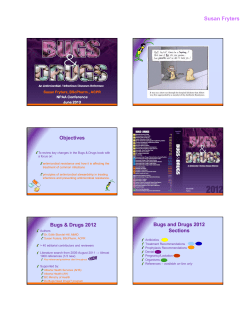
Indian Journal of Medical Case Reports ISSN: 2319–3832(Online)
Indian Journal of Medical Case Reports ISSN: 2319–3832(Online) An Online International Journal Available at http://www.cibtech.org/jcr.htm 2012 Vol. 1 (2-3) Jul-Sept. & Oct.-Dec., pp.17-19/Padwal et al. Case Report VANCOMYCIN INDUCED RED MAN SYNDROME IN NEONATE: A CASE REPORT AND BRIEF REVIEW OF LITERATURE * Sudhir L. Padwal, Vijay M. Motghare, Harshal N. Pise, Swapnil C. Jaykare and Vinod S. Deshmukh * Department of Pharmacology, SRTR Govt. Medical College, Ambajogai, District Beed Maharashtra * Author for Correspondence ABSTRACT Vancomycin is an antibiotic with rapid resurgence during past few years. The emergence of Methicillin Resistant Staphyloccus Aureus (MRSA) and growing concern about enterococcal diseases has dramatically sparked the uprising of Vancomycin. It is a glycopeptide antibiotic active against gram positive organism. Vancomycin is associated with two types of hypersensitivity reactions red man syndrome and anaphylaxis. Red Man syndrome is more common type infusion related hypersensitivity reaction. It is more common with rapid infusion of Vancomycin. Red Man Syndrome is usually presents with pruritus, erythematous rash commonly involving head, neck and upper part of body and less frequently with chest pain, hypotension and cardiovascular collapse. Discontinuation of antibiotic and treatment with antihistaminic can abort most of the reactions. Herewith, presenting a case report of Vancomycin induced Red Man Syndrome in premature low-birth weight neonate. Key Words: Antihistaminic, Neonate, Red Man Syndrome (RMS), Vancomycin INTRODUCTION Vancomycin is an antibiotic discovered more than 50 years ago and used only for serious infections caused by gram positive organism. But last few years has witnessed the rapid resurgence of Vancomycin. The growing concern of rapidly spread of resistance in first line of antibiotic has dramatically sparked the uprising of Vancomycin. Vancomycin was first found by Dr. E. C. Kornfield in 1952 in sample of mud send to him by a missionary in Borneo. It is naturally produced by organism called Amycolatopsis Orientalis (Levine, 2006). Vancomycin act by inhibiting cell wall synthesis. It is generally reserved drug and used only for life- threatening infections. The major indications for the use of Vancomycin include infections caused by Methicillin Resistant Staphyloccus Aureus (MRSA) and Multidrug Resistant Staphylococcus Epidermis (MRSE), treatment of pseudomembranous colitis. It is an alternative drug when allergy precludes the use of penicillins and cephalosporins. The adverse drug reactions due to Vancomycin include ototoxicity, nephrotoxicity, neutropenia, fixed drug eruptions. The Vancomycin is associated with two types of hypersensitivity reactions anaphylaxis and Red Man Syndrome. Most common adverse drug reaction with the use of Vancomycin is Red Man Syndrome (Lori, 2001). Herewith presenting a case of Vancomycin induced Red Man Syndrome in a low birth weight neonate and brief review of literature regarding the serious adverse drug reactions/ sideeffects of Vancomycin and necessary precautions that should be taken while using the drug. CASES A Low Birth Weight male neonate born by normal vaginal delivery was admitted in NICU with difficulty in respiration and bluish extremity. He was admitted as a case of septicemia. The neonate was 6 hours old and weighing about 1.5 kg born at 33 weeks of gestation. Patient was diagnosed as preterm with low birth weight having septicemia. At time of presentation the neonate was cyanosed, grunting was present, heart rate of less than 80/min, hypothermic. Due to the high incidence of MRSA in clinical setup and availability of drugs, patient was started on Vancomycin intravenously at a dose of 45 mg/kg in Dextrose 17 Indian Journal of Medical Case Reports ISSN: 2319–3832(Online) An Online International Journal Available at http://www.cibtech.org/jcr.htm 2012 Vol. 1 (2-3) Jul-Sept. & Oct.-Dec., pp.17-19/Padwal et al. Case Report Figure 1: Red Man Syndrome Table 1: Laboratory Investigations Test Bilirubin Total Direct Indirect Hemoglobin Blood Group Total Leukocyte Count Platelet Count C- Reactive Protein Eosinophil count Results 24.5mg/dl 10mg/dl 14.5mg/dl 20 gm% A Rh+ve 16,700 1,70,000 Negative 250mm3 10% 24 hourly, Amikacin 10 mg BD for 10 days. Aminophyllin 3mg was given due to dyspnea. The neonate developed erythema over whole of the body mainly on legs and becomes lethargic immediately after completion of infusion. Vancomycin infusion was stopped and anti-histaminic diphenhydramine was administered. Patient was also started on Dopamine due to development of hypotension. Erythema improved after administration of antihistaminic. Patient recovered thereafter. Naranjo’s adverse drug reaction probability scale has been applied to assess causality (Naranjo, 1981). The result found to be “Possible”. DISCUSSION Vancomycin in past has been known as “Mississippi mud” due to its association with many adverse drug reactions including hypersensitivity (anaphylaxis, Red Man syndrome), neutropenia. The impurities associated with Vancomycin were thought to be associated with the reactions. So the purifications of Vancomycin did result in decrease in reactions (Sivagnanam, 2003). But still today use of Vancomycin is associated with many adverse drug reactions. Adverse drug reactions to Vancomycin may range from mild pruritis and redness which may often go unnoticed to severe hypotension and cardio-vascular collapse. Most common adverse drug reactions are hypersensitivity reactions. Two types of hypersensitivity reactions are noted with Vancomycin, viz., hypersensitivity and constellation of signs and symptoms called as Red Man Syndrome (Lori, 2001). The studies have reported the incidence of RMS varies from 0-35%. (Wallace, 1991) This reaction peculiar to Vancomycin, can also be seen with other antibiotics like teicoplanin, ciprofloxacin, amphotericin B, rifampicin etc. 18 Indian Journal of Medical Case Reports ISSN: 2319–3832(Online) An Online International Journal Available at http://www.cibtech.org/jcr.htm 2012 Vol. 1 (2-3) Jul-Sept. & Oct.-Dec., pp.17-19/Padwal et al. Case Report The signs and symptoms of RMS may range from mild pruritus to severe hypotension and chest pain. It typically consists of pruritus, erythematous rash involving head, neck and upper part of body. Less commonly it may results in angiodema, chest pain, dyspnoea and in severe cases hypotension and cardiovascular collapse (4). RMS is an infusion related reaction. Healy Daniel in 1990 has shown that, it is more often seen with 1-hour infusion than 2-hours (Healy, 1990). So it is advisable to use small doses in frequent interval than large doses in small interval. RMS is an anaphylactoid reaction and is caused by release of histamine due to degranulation of mast cells and basophills independent of preformed IgE and complement levels. As this reaction is due to release of histamine naturally the pretreatment with anti-histaminics should reduced the severity of reactions (Sivagnanam, 2003). Indeed it has been shown that pretreatment with antihistaminic reduces the side effect from rapid infusion of Vancomycin. Anti-histaminics are also useful in treatment of RMS and treatment with antihistaminic can abort most of the reactions (Wallace, 1991). On contrary, one of the study it has shown than RMS is not associated with histamine release and raise plasma histamine concentration do not predict the reaction. So other mediators may also be involved in this reaction (O'Sullivan, 1993). Many others drugs (morphine, codeine) also causes release of histamine from mast cells. So coadministration of these agents may increase the probability of RMS so should not be used concurrently. Teicoplanin is structurally similar to Vancomycin but most of the patients developing reactions to Vancomycin have tolerated teicoplanin, so teicoplanin can be used instead of Vancomycin (Hung, 2009). Levy and Koren et al., in 1990 have shown that there was no association between concentration and the occurrence of RMS suggesting that this is an idiosyncratic and not a concentration dependent phenomenon. This case may be of idiosyncratic type (Levy, 1990). Most common adverse drug reaction to Vancomycin is red man syndrome which is characterised by pruritus, erythema and flushing of upper part of body. Red Man Syndrome is infusion related reaction and is less common when low dose is given frequently. Rapid infusions should be avoided. When rapid infusion is mandatory, premedication with anti-histaminics should be used to decreases incidence of RMS. If reaction occurs, treatment with antihistaminic like diphenhydramine can treat most of reactions. More serious reactions require intravenous fluids, vasopressors. REFERENCES Healy DP, Sahai JV, Fuller SH and Polk RE (1990). Vancomycin-Induced Histamine Release and "Red Man Syndrome": Comparison of 1- and 2-Hour Infusions. Antimicrobiology Agents Chemother 34 550-554. Hung YP, Lee NY and Chang CM et al., (2009). Tolerability of teicoplanin in 117 hospitalized adults with previous vancomycin-induced fever, rash, or neutropenia: a retrospective chart review. Clinical Therapy 31 1977. Levine DP (2006). Vancomycin: A History. CID 42 S5-S12. Levy M, Koren G, Dupuis L and Read SE (1990). Vancomycin-Induced Red Man Syndrome. Pediatrics 86 572-580. Lori D Wazny and Behnam D (2001). Desensitization protocols for Vancomycin hypersensitivity. Annals of Pharmacotherapy 35 1458-1464. Naranjo CA, Busto U, Sellers EM, Sandor P, Ruiz I and Roberts EA et al., (1981). A method for estimating the probability of adverse drug reactions. Clinical Pharmacology Therapy 30 239-245. O'Sullivan TL, Ruffing MJ, Lamp KC, Warbasse LH and Rybak MJ (1993). Prospective evaluation of red man syndrome in patients receiving Vancomycin. Journal of Infectious Diseases 168(3) 773-776. Sivagnanam S and Deleu D (2003). Red man syndrome. Critical Care 7 119-120. Wallace MR, Mascola JR and Oldfield EC (1991). Red man syndrome: incidence, etiology and prophylaxis. Journal of Infectious Diseases 164 1180-1185. 19
© Copyright 2025















